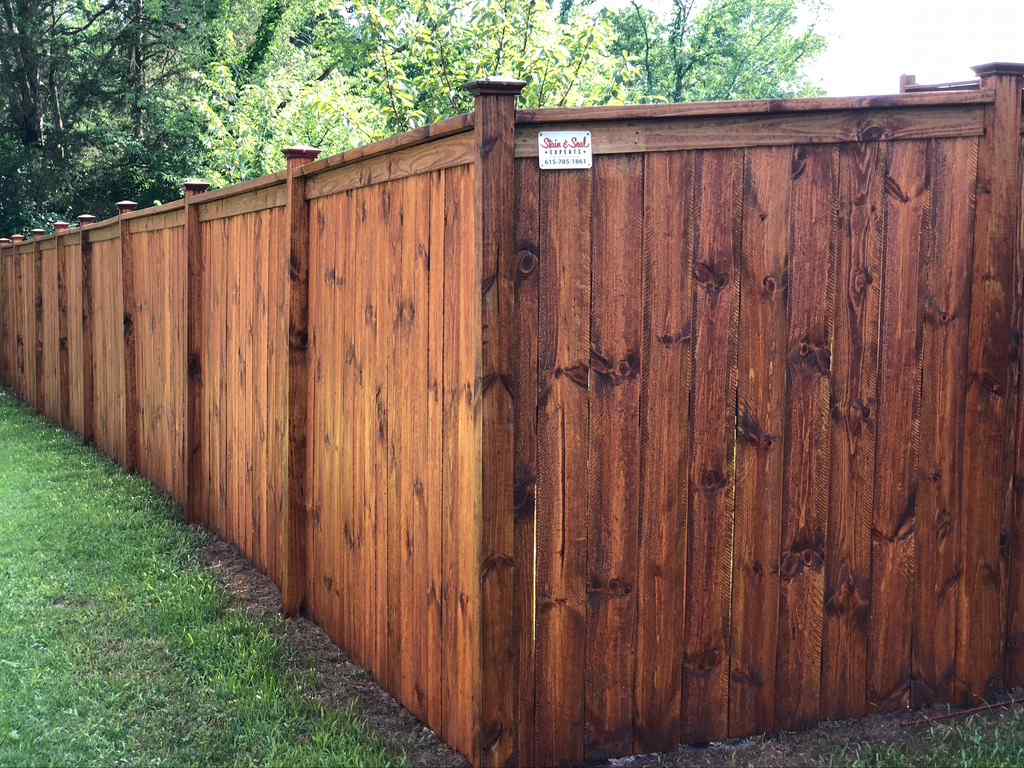How to Select the Right Fencing Discoloration for Your Residential Or Commercial Property
When it comes to improving the look and toughness of your property's fencing, selecting the ideal tarnish is a critical decision that calls for mindful factor to consider. How can you guarantee that you select the best fencing stain that lines up with your home's design and maintenance requirements?
Understanding Timber Types
To pick the ideal fencing discolor, it is important to have a detailed understanding of the various kinds of timber generally used for secure fencing. The option of timber plays an essential duty in establishing the durability and general visual appeals of the fence. Cedar is a prominent selection as a result of its all-natural resistance to decay and insects, making it a durable option for exterior frameworks. Pine is one more typical wood used in secure fencing, recognized for its price and convenience of discoloration. However, pine is much more susceptible to bending and rotting compared to cedar. Redwood is a premium choice recognized for its striking look and all-natural toughness, though it features a greater cost. When selecting a fence discolor, it is necessary to think about the sort of wood being used to guarantee compatibility and ideal protection. Comprehending the characteristics of various timber types will certainly aid you make an educated decision when it concerns selecting the best fence discolor for your building - Fence Staining Near Me.
Choosing the Right Color
Picking an appropriate hue for your fencing tarnish is a crucial choice that significantly impacts the general visual allure of your residential or commercial property. The color you choose must match the style of your home, mix sympathetically with the environments, and mirror your personal preference. When choosing a color, take into consideration the existing shade scheme of your property. For an all-natural look, natural tones like browns, greens, or grays work well. These shades can assist the fence mix right into the landscape and develop a cohesive appearance. If you prefer a more contemporary or strong appearance, take into consideration choosing for darker tones like black or deep charcoal for a striking contrast. Lighter colors such as whites or light grays can make a fence show up bigger and add a touch of style to your property. Inevitably, the ideal shade selection will certainly improve the elegance of your fence and boost the overall aesthetic allure of your home.

Taking Into Consideration Openness Degrees
When choosing the appropriate color for your fence stain, another crucial aspect to take into consideration is the degree of openness that will certainly best match your residential or commercial property's visual and upkeep demands. Transparency levels in fencing stains usually fall under 3 groups: clear, semi-transparent, and strong. Clear spots enable the natural charm of the timber to show through while supplying minimal protection versus the elements. They are excellent for new or well-maintained fences where showcasing the timber grain is a concern. Semi-transparent stains offer an equilibrium between shade improvement and defense, allowing some wood grain to be noticeable while supplying modest shielding from UV rays and dampness. Strong spots, on the other hand, give the most security as they entirely cover the wood with a nontransparent finish. These are suitable for older fencings or those seeking considerable protection or color modification. Think about the degree of exposure your fencing faces, the wanted maintenance frequency, and the visual you wish to achieve when selecting the appropriate transparency level for your fencing discolor.
Assessing Maintenance Requirements
Taking into consideration the long life and maintenance of your fence, evaluating the upkeep needs is essential in determining the most appropriate fencing stain for your residential or commercial property. The degree of maintenance needed for your fencing can differ depending on factors such as the kind of wood, climate condition in your area, and your individual choices.
When examining upkeep demands, it is important to consider the toughness of the fencing stain. Some spots call for even more frequent reapplication than others, so selecting a stain with a much longer lifespan can help in reducing the overall upkeep needs of your fencing (Fence Staining Service). Furthermore, variables such as resistance to UV rays, water, and mildew can influence how frequently you require to re-stain your fencing

Evaluating Samples Before Application
Before using any type of fencing discolor, it is recommended to conduct example examinations to make certain compatibility with the timber and desired aesthetic result (Fence Staining Nashville TN). Checking examples allows you to assess This Site just how the stain will connect with the certain kind of timber utilized in your fencing, as different timbers can soak up stains in different ways. To begin, choose a tiny inconspicuous area of the fence to apply the discolor samples. It is advised to examine multiple stain choices on this section to contrast colors and surfaces. Take into consideration exactly how the tarnish looks when completely dry, as it may appear different from its wet application. Furthermore, observe exactly how the discolor enhances the existing components in your outside space, such as landscaping or the color of your home. Keep in mind of exactly how the discolor stands up to climate condition like sunshine and wetness. By testing samples before full application, you can make an informed choice that improves the general look of your building while safeguarding the wood effectively.
Final Thought
In conclusion, selecting the suitable fence discolor for your residential property entails recognizing the wood kind, choosing the appropriate color, taking into consideration openness levels, evaluating upkeep requirements, and screening samples prior to application (Fence Staining). By taking these variables right into consideration, you can guarantee that your fence stain matches your building while providing the essential defense and durability. Make a notified choice to enhance the look and long life of your fencing